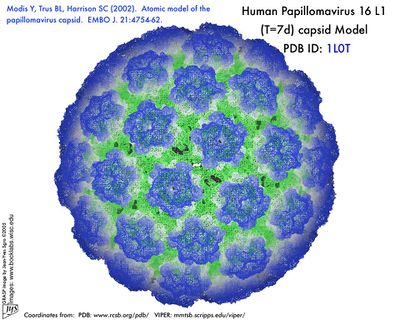Human Papilloma Virus: Difference between revisions
No edit summary |
|||
| Line 17: | Line 17: | ||
<br> | <br> | ||
===Description=== | ===Description=== | ||
Papillomavirus are small virus with DNA from the family papovavirdae which measure 50 nm in diameter, lack membrane, and their capsids have an icosahedral form composed of 72 capsomeres [#References[3]]].The DNA of HPV is circular, double chain, and contains approximately 8000 base pairs [#References[3]]]. Persistent infection by human papilloma virus (HPV) is considered the main causative agent of cervical cancer. According to their oncogenic risk, HPV are classified as low-risk HPV (LR-HPV) or high-risk HPV (HR-HPV) [#References[3]]]. Classification is based on the origin and degree of homogeneity of the DNA. | |||
==References== | ==References== | ||
Revision as of 08:27, 26 July 2015

]

]
Etiology/Bacteriology
Taxonomy
|Family = Papillomaviridae
|Genus = Alphapapillomavirus
|species = Human Papillomavirus
NCBI: Taxonomy Genome: Genome
Description
Papillomavirus are small virus with DNA from the family papovavirdae which measure 50 nm in diameter, lack membrane, and their capsids have an icosahedral form composed of 72 capsomeres [#References[3]]].The DNA of HPV is circular, double chain, and contains approximately 8000 base pairs [#References[3]]]. Persistent infection by human papilloma virus (HPV) is considered the main causative agent of cervical cancer. According to their oncogenic risk, HPV are classified as low-risk HPV (LR-HPV) or high-risk HPV (HR-HPV) [#References[3]]]. Classification is based on the origin and degree of homogeneity of the DNA.
References
1. College of Arts and Sciences | The University of Oklahoma. Study Abroad.
2.6. Virology.wisc.edu. 2002. Atomic Model of papillomavirus capsid.
